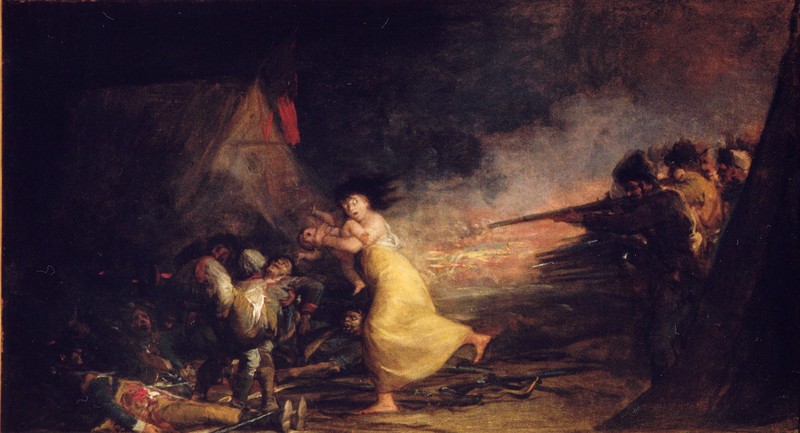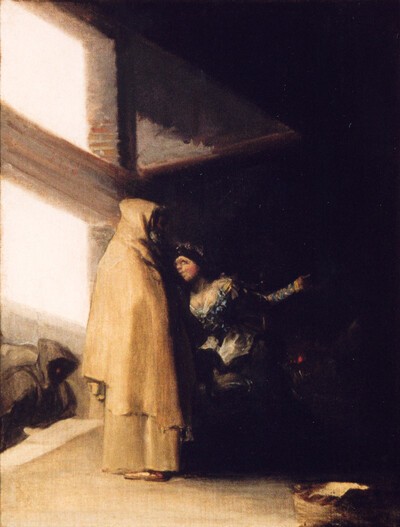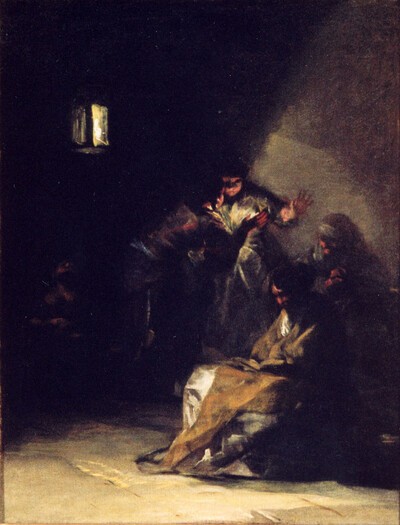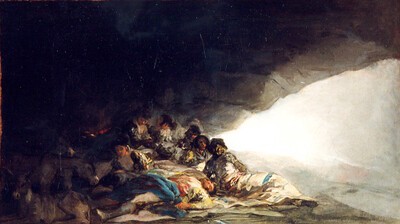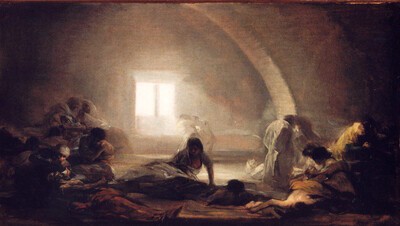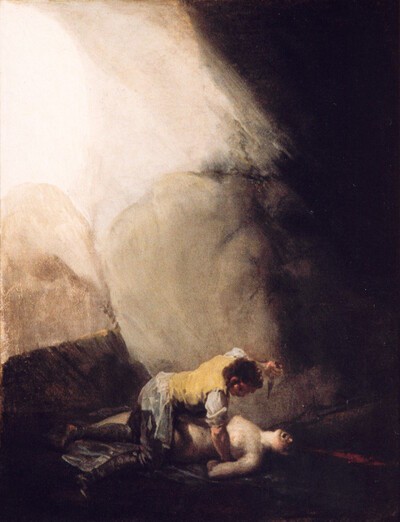- Cronología
- Ca. 1808 - 1810
- Ubicación
- Marquis of La Romana Collection, Madrid, Spain
- Dimensiones
- 33 x 57 cm
- Técnica y soporte
- Oil on canvas
- Reconocimiento de la autoría de Goya
- Undisputed work
- Titular
- Marquis of La Romana Collection
- Ficha: realización/revisión
- 11 May 2010 / 15 Jun 2023
- Otros títulos:
-
Attack on a Military Camp (Ataque a un campamento militar)
The complete series of eleven paintings was acquired from Goya by the Majorcan collector Juan de Salas, father of Dionisia Salas y Boxadors, who was married to Pedro Caro y Sureda (Palma de Mallorca, 1761-Cartaxo, Portugal, 1811), III Marquis of La Romana.
The painting was inherited by its current owners.
Due to its dimensions and to the use of an orange-coloured preparation on the canvas, this work can be connected to Gypsy Cave and Interior of a Hospital.
This scene takes place at night inside a military camp. On the left-hand side stands a red tent, adorned with standards and banners. On the ground are a number of dead soldiers wearing blue coats with red and white cuffs and ochre-coloured trousers, telling us that they belong to one of the Spanish regiments active during the Spanish War of Independence. Running towards them is a group of civilians, modestly dressed commoners. Two of them are carrying a wounded man and, slightly further behind, a woman dressed in yellow, drawing our gaze into the centre of the composition, is clinging on to her naked child. With an expression of horror on her face, she is turning her head to look back at the platoon of soldiers behind her, just as they open fire. These other soldiers are part of a foreign army, probably belonging to the forces of Napoleon.
The only source of light in the painting is the flashes of the rifle shots, a detail which further heightens the drama of the scene. The group of civilians was probably trying to find shelter in the Spanish camp, which had been taken by surprise by the French soldiers, who show no mercy to these innocent people, either.
Just as occurs in Third of May, the executioners do not show their faces and have their backs turned to the viewer. This is a device that Goya also used in some of the etchings in the Disasters of War series (no. 2, With or without reason, and no. 32, Why?, for example).
Similarly, the woman who is trying to protect her child connects this work to another of the etchings in this same series, no. 4, entitled I saw this.
-
Goya 1900Ministerio de Instrucción Pública and Bellas ArtesMadrid1900consultant editors Aureliano de Beruete, Alejandro Ferrant, Marqués de Pidal and Ricardo Velázquez. May 1900cat. 56
-
Pinturas de GoyaMuseo Nacional del PradoMadrid1928consultant editor Fernando Álvarez de Sotomayor. From April to May 1928cat. 41
-
Goya. El Capricho y la Invención. Cuadros de gabinete, bocetos y miniaturasMuseo Nacional del PradoMadrid1993from November 18th 1993 to February 15th 1994. Exhibited also at the Royal Academy of Arts, London, March 18th to June 12th 1994 and The Art Institute of Chicago, Chicago, July 16th to October 16th 1994, consultant editors Manuela B. Mena Marqués and Juliet Wilson-Bareaucat. 81
-
Goya en tiempos de guerraMuseo Nacional del PradoMadrid2008consultant editor Manuela B. Mena Marqués, from April 14th to July 13th 2008cat. 53
-
Goya: Order and disorderMuseum of Fine ArtsBoston2014cat. 189
-
GoyaBasle2021p. 223
-
L'œuvre peint de Goya. 4 volsParís1928-1950p. 250, cat. 222
-
Vie et ouvre de Francisco de GoyaParísOffice du livre1970p. 263, cat. 921
-
BarcelonaPolígrafa1970vol. I, pp. 294 y 295, cat. 355
-
L’opera pittorica completa di GoyaMilanRizzoli1974cat. 495
-
Francisco de Goya, 4 vols.ZaragozaCaja de Ahorros de Zaragoza, Aragón y Rioja1980-1982vol. III, p. 191
-
Goya. El capricho y la invención. Cuadros de gabinete, bocetos y miniaturasMadridMuseo del Prado1993pp. 282, 283, 284, 285, 286 y 287 (il.),
-
Goya en tiempos de guerraMadridMuseo Nacional del Prado2008pp. 234, 235, 236 (il.) y 237, cat. 53
-
Goya: Order & DisorderBostonMuseum of Fine Arts Boston Publications2014pp. 282-283
